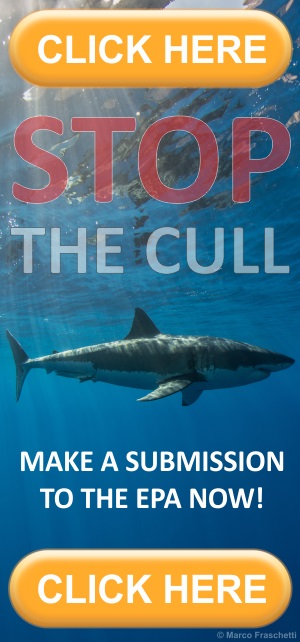Action Alert:
Stop the WA shark cull
Article posted by Support Our Sharks and prepared by Prof. Jessica Meeuwig (14 June 2014)
 The Western Australian shark cull policy
is now being assessed by
the Environmental Protection Authority (EPA);
this is
thanks to the
thousands of public submissions they received in response to the
WA Government's request for the program to proceed
for another 3 years.
Now is our chance to tell the EPA why they should intervene and
prevent this program from going ahead.
The Western Australian shark cull policy
is now being assessed by
the Environmental Protection Authority (EPA);
this is
thanks to the
thousands of public submissions they received in response to the
WA Government's request for the program to proceed
for another 3 years.
Now is our chance to tell the EPA why they should intervene and
prevent this program from going ahead.
The full EPA Public Environmental Review can be viewed here.
Submit a comment to the EPA (by July 7th) stating why they should Stop The Cull.
EPA submission period closes in:
We need to send a clear message to the EPA that this policy is environmentally unacceptable and that they must take action to stop it. You can help by taking just one minute of your time to make an individual submission via the link to the left. To make the process quick and easy, we have provided a template below that you are welcome to copy and paste, but we also encourage you to personalise your submission by adding your own comments.
Individual submissions are extremely powerful, and if you intend to make a submission, feel free to use parts of or the entire template below.
Submission template to the EPA opposing the WA shark cull policy
I strongly encourage the Environmental Protection Authority
(EPA) of Western Australia (WA) to
reject the Government of Western Australia’s proposal for a 3
year, lethal drum line program as part of its broader shark
hazard mitigation policy. There is insufficient scientific
evidence to justify the continued destruction of wildlife that
are listed nationally and internationally as of conservation
concern, both in terms of ocean user safety, and with respect to
potential impacts on these shark populations.
(1)
The proposal presents no evidence to suggest that the lethal
drum line program, as implemented, will make ocean users safer.
The document justifies safety outcomes on the back of netting or
mixed netting / drum line programs despite netting having been
rejected in WA on the grounds of their excessive impacts on
ocean wildlife. The proposal ignores relevant hook-only examples
from Hawaii (that showed no improved safety outcomes despite a
16 year long line program that captured nearly 300 tiger sharks
a year (comparable to the expected take of tiger sharks in WA’s
program)) and Queensland beaches where only drum lines are used
(Wetherbee
et al., 1994).
(2)
The proposal does not adequately assess non-lethal alternatives
such as the
South African shark spotter program and Brazil’s
tagging program as viable options for Western Australia (Hazin
and Afonso, 2013). We are
particularly interested in the shark spotter program as it has
directly provided surfers with increased knowledge about the
timing and location of white sharks at popular surf breaks so in
addition to direct warnings, surfers have better information to
evaluate risk.
(3)
White sharks are globally threatened and as such we should be
supporting recovery rather than adding additional
pressure. Estimates of white shark population numbers are
uncertain and the Department’s ability to predict how many they
will catch is also uncertain. Thus a more appropriate approach
in assessing potential risk should be applied. A recent report
from South Africa, based on genetics and mark-recapture
analyses, suggests that the South African population of white
sharks, once considered to be the largest in the world, is an
order of magnitude smaller than previously estimated(Andreotti
et al. 2014)
and the best peer-reviewed estimate to date suggests
approximately 700 breeding white sharks in south western
Australia (Blower
et al. 2012).
As
the targets are also all large individuals that are mature or
nearly mature, significant caution should be applied in
evaluating population risks and that is not the case in this
proposal.
(4)
The proposal considers that there will be a “negligible” effect
of capturing an estimated 900 tiger sharks over the period
because the tiger shark population is in reasonable condition,
tiger sharks are relatively resilient to exploitation and the
proposed catch is about 50% of historical catch levels in
fisheries that are now closed. No estimates of population size
are presented, the assessment ignores the sex ratio of large
(>3m) females to males in the trial (4:1; equating to 720
females over the proposal period) and the comparison to
historical catch does not consider whether there is ongoing IUU
fishing of this population in northern Australia (and elsewhere)
nor whether that historical catch level was ever actually
sustainable.
(5)
Broad scale ecological impacts are assessed as negligible on the
grounds that there was no evidence that there were ecological
impacts on the ecosystem associated with shark removal during
the height of the shark fishery in the region. Evidence of the
effects on marine ecosystems as a result of the removal of apex
predators are increasingly being identified but require targeted
research to do so (with appropriate controls). It is not clear
that there was ever a proper study of trophic cascades
associated with the commercial fishery in this region and thus
the posited lack of this in the past is not grounds for
dismissing them now.
(6)
The proposal frames potential impacts on the two regional World
Heritage Areas (Shark Bay and Ningaloo) only in terms of direct
impacts of drum line deployment in these areas. It ignores the
connectivity of these systems with the south west in terms of
tiger shark movements and thus the potential impacts on these
region as a result of the removal of upwards of 40 tonnes of
tiger shark a year.
THIS IS OUR CHANCE TO STOP THE CULL -
PLEASE ENCOURAGE OTHERS TO MAKE A SUBMISSION BY SHARING THIS PAGE
-----------------------------------------------
Leave your comments below and the team will try and answer
them as soon as possible.
Other Interesting Articles:

